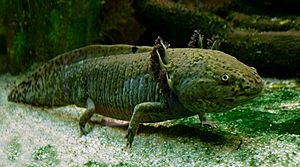Neoteny facts for kids
Neoteny is when an animal or human keeps some of its baby or young features even when it grows up and can have its own babies. It's like staying a "kid" in some ways, but still becoming an adult.
Contents
What is Neoteny?
Neoteny is a special kind of development where an animal's body grows slower than usual. However, its ability to reproduce (have babies) develops at the normal speed. This means an animal can become an adult and have offspring while still looking like a younger version of its species.
A Famous Example: The Axolotl
A great example of neoteny is the axolotl. This is a type of salamander that normally lives in water. Most salamanders lose their gills and move onto land as they grow up. But the axolotl keeps its feathery gills and stays in the water its whole life. Even though it looks like a young salamander, it can still lay eggs and have baby axolotls.
Neoteny in Humans
Scientists have often suggested that humans show some signs of neoteny. This means that adult humans have some features that are more like young great apes than adult great apes. Our bodies develop in a way that keeps some "childlike" traits.
Human Traits Showing Neoteny
Compared to adult great apes, adult humans have several features that are similar to young apes. These include:
- A flatter face
- A wider face
- A larger brain
- Less body hair
- Less hair on the face
- A smaller nose
- Smaller brow ridges (the bony part above the eyes)
- Smaller teeth
- A smaller upper jaw
- A smaller lower jaw
- Thinner skull bones
- Legs that are longer than arms
- Larger eyes
- An upright way of standing and walking
These traits suggest that human development might have slowed down in some ways, keeping us looking more "juvenile" even as we become adults.
Images for kids
See also
 In Spanish: Neotenia para niños
In Spanish: Neotenia para niños



